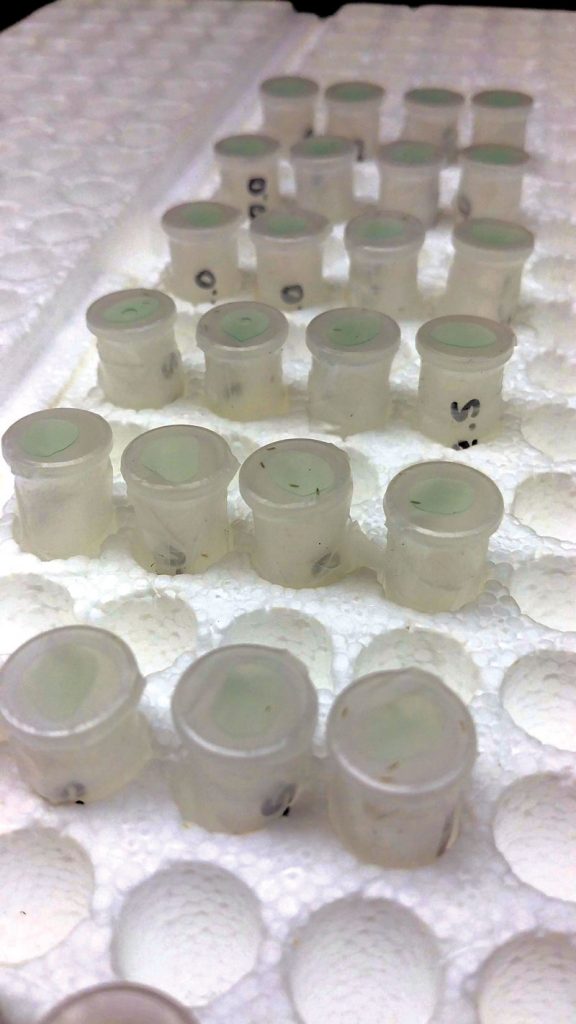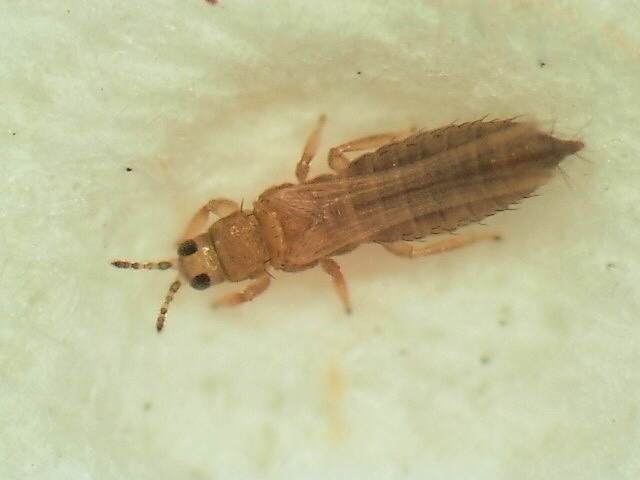Onion thrips migrating from onion fields that have recently matured or lodged into unmatured fields can cause their populations to skyrocket. This is especially problematic where onions of differing maturity are grown close together. Onion thrips feeding can cause excessive leaf dieback, result in transmission of diseases including Iris yellow spot virus, and ultimately reduce bulb size and yield (Fig. 1).
This pest is principally controlled with insecticides. In New York, Radiant SC, a product containing spinetoram, is the heaviest-hitting insecticide available to growers. It is capable of reducing thrips populations that exceed five thrips per leaf. For reference, the standard spray threshold is one thrips per leaf.
Lack of Control
At the end of the growing season, battling the last waves of onion thrips in remaining onion fields before harvest has become a challenge, especially in areas like the Elba Muck in Orleans County, New York, where onions of various maturity stages are grown together. Recently, there have been cases where high rates (8-10 fl. oz.) of Radiant have not been effective at controlling large populations of onion thrips at the end of the growing season.
One reason for this lack of control could be that the thrips populations are so high that no insecticide would be effective. Such a situation can exist when onion thrips migrate into an onion field from nearby onion fields that have matured or have been recently pulled. Another possibility for the apparent lack of control is that the thrips populations have developed resistance to Radiant.
Onion thrips have a history of resistance to insecticides. Onion thrips typically reproduce asexually (i.e. do not need to mate with males), produce a lot of offspring, and have multiple short and overlapping generations every growing season. This combination of traits puts them at high risk for developing resistance to insecticides.
Notably, overuse of the pyrethroid Warrior II (with the active ingredient lambda-cyhalothrin) resulted in the development of resistance in the early 2000s, less than 10 years after Warrior was registered for use in New York. Globally, resistance of onion thrips populations has been documented to several classes of insecticides, including pyrethroids, organophosphates, carbamates, avermectins, spinosyns and neonicotinoids.
Thrips’ biology and history of developing resistance to insecticides puts them at risk for losing their susceptibility to Radiant. However, determining if a population is, in fact, resistant requires sampling and testing populations in the laboratory and ideally comparing their susceptibility to known susceptible and resistant populations.

Insecticide Resistance Bioassay
In order to explain the lack of control using Radiant late in the season in some New York fields, we conducted a feeding bioassay in the laboratory to determine whether two seemingly uncontrollable thrips populations from New York were susceptible to Radiant. Results were compared to baseline data that we generated in 2017 and 2018 from populations collected across New York.
In order to establish a sense of thrips susceptibility to Radiant in Upstate New York onion fields, we evaluated onion thrips populations from four counties in 2017 and 2018. We modified an existing thrips feeding bioassay in which onion thrips adults are placed in small vials that contain different concentrations of Radiant SC (Fig. 2). After 48 hours, the numbers of live and dead thrips were recorded, and the lethal concentration of insecticide needed to kill 50 percent of a population (LC50) was determined for each population (Table 1). We estimated that a population resistant to Radiant would have an LC50 greater than 177-295 ppm (estimated for field rates of 6-10 fl. oz./acre). The thrips populations we sampled in 2017 and 2018 had LC50s that ranged from only 2.07 to 5.08 ppm, indicating that they were susceptible to Radiant.

2019 Thrips Populations
In 2019, both seemingly uncontrollable thrips populations came from direct-seeded onion fields that were relatively centrally located within the Elba Muck, surrounded by both transplanted and direct-seeded onion fields.
The first field, OR2, was positioned between earlier maturing transplanted onions located to the north, south and east, and direct-seeded onions to the west. This field received three applications of Radiant including a border spray at the south end to control an influx of thrips from lodging transplants at the beginning of August, followed by two applications of Radiant 10 days apart.
The second field, OR1, was surrounded by other direct-seeded onions to the east and west and received a total of two applications of Radiant applied during late August and early September in consecutive weeks.
Bioassays of onion thrips populations from OR1 were also conducted in 2017 and 2018. Thrips from OR1 and OR2 were sampled for the bioassay in late August 2019. The results of the 2019 bioassays indicated that both onion thrips populations were susceptible to Radiant. With LC50s of only 2.8 ppm (OR2) and 3.4 ppm (OR1), these populations had similar levels of susceptibility to Radiant as those tested in 2017 and 2018 (Table 1).
Based on these results, lack of thrips control was most likely caused by Radiant not being able to keep up with the continuous inundation of thrips coming out of neighboring matured onion fields rather than due to resistant thrips populations.

Note that a population resistant to Radiant would have an LC50 greater than 177-295 ppm (estimated for field rate 6-10 fl. oz./acre).
Insecticide Resistance Management
Radiant remains an effective and powerful tool for thrips management. Radiant’s continued efficacy is no doubt due to careful and thoughtful use of this product along with other insecticides used in a manner to mitigate resistance. There are several steps that can be taken to continue this success using Insecticide Resistance Management (IRM):
- Use an Integrated Pest Management (IPM) approach, and diversify management tactics.
- Follow action thresholds, scout fields to assess pest levels and only spray when necessary.
- Rotate modes of action (classes of insecticides) so that thrips are not exposed to the same chemistry repeatedly throughout the growing season. For spray sequence recommendations, see Christy Hoepting’s and Brian Nault’s 2019 Cornell Guidelines for Onion Thrips Management in Onion at https://cvp.cce.cornell.edu/submission.php?id=587.
For more information about IRM, see the recommendations outlined by the Insecticide Resistance Action Committee at www.irac-online.org.

